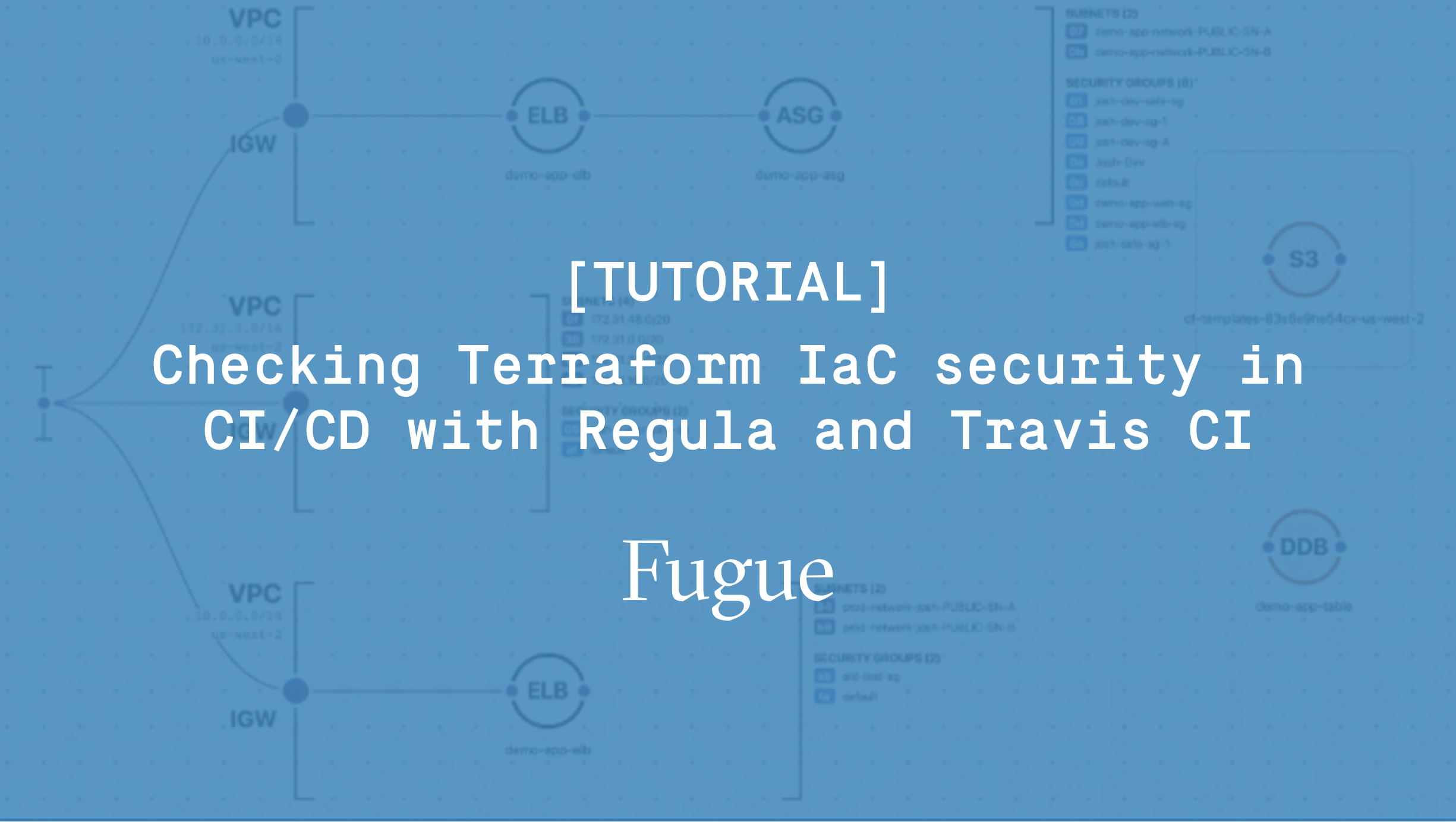
Regula 1.0 makes it easy to check Terraform and CloudFormation infrastructure as code (IaC) for security vulnerabilities and compliance violations, especially in continuous integration/continuous delivery (CI/CD) pipelines (read about the Regula 1.0 launch in Help Net Security and on our blog here).
In this blog post, we’ll demonstrate how to integrate Regula with Travis CI for automated testing of Azure resources declared in Terraform. Travis will kick off a build for the branch and a build for the PR. We’ll show how Regula catches a security vulnerability and fails the CI build, and we’ll show how to remediate the violation so the build passes.
When we’re done, the CI/CD pipeline will work like so:
- You commit IaC to a branch.
- You push the commits and create a PR, triggering a Travis CI build.
- Travis CI runs Regula against your repository.
- If the IaC in your repo passes all of Regula’s checks, the Travis build passes. Otherwise, it fails.
Tip: The pipeline above works great with other CI tools, too -- so even if your organization doesn't use Travis, you can follow the same general steps to check your IaC in CI/CD with Regula.

A passing build and a failed build on Travis CI, after checking IaC with Regula
Getting started
There are a couple prerequisites for this walkthrough:
- Create a new GitHub repo
- Sign up for a (free) Travis CI account
Set up GitHub repo
In your terminal, git clone your new repo.
Next, create a new branch:
git checkout -b regula-exampleSince we’ve conveniently created a repo with all the code you need, you can simply download the ZIP of our regula-travis-example repo and unzip the files into your own repo’s directory. You should see these files:
- dev_network/main.tf – a Terraform file with an intentional vulnerability
- .travis.yml – a Travis CI build configuration file
We’ll explain what each one does shortly.
Set up Travis CI
Now we’ll set up Travis CI to run builds for your new repository. Access your Travis Dashboard, click on your profile picture in the top right, and select Settings.
In the Settings menu, click the Activate button under GitHub Apps Integration and then select the repository you created.
Once we add a build configuration file (which we’ll do momentarily!), Travis will be able to run builds for your repository.
The files
Let’s examine the files you added to your repository, starting with dev_network/main.tf.
The vulnerable Terraform
The dev_network/main.tf Terraform HCL file declares the following Microsoft Azure resources:
- Resource group
- Network security group (NSG) with one security rule
- Virtual network
- Network Watcher
- Log Analytics workspace
- Network Watcher flow log
- Storage account
- Random string, to generate a unique storage account/resource group name
For learning purposes, we’ve intentionally created a security vulnerability in the NSG with the single security rule (so don’t provision this Terraform in the real world!). If you take a close look at lines 31-41, you’ll see that port 22 is open to the world, ["0.0.0.0/0"]:
security_rule {
name = "dev-nsg-rule"
priority = 100
direction = "Inbound"
access = "Allow"
protocol = "Tcp"
source_port_range = "*"
destination_port_ranges = ["22"]
source_address_prefixes = ["0.0.0.0/0"]
destination_address_prefix = "*"
}We certainly wouldn’t want this to make it to production! Fortunately, this is exactly the sort of issue that Regula can catch during testing. Regula has hundreds of rules that check for security vulnerabilities and compliance violations, including wide-open ports like this one.
We’re going to walk through the process of committing this code to a GitHub repo so we can see Regula in action. But first, let’s examine the Travis build configuration file so we can see exactly what will happen.
Travis configuration
.travis.yml tells Travis to do the following when a build is triggered:
- Download, unzip, and install Regula in "$HOME/.local/bin"
- Create a temporary file for Regula output
- Run Regula to check all IaC in the repo for security and compliance, writing output to stdout and the temp file
- Show the number of passed and failed rules
- If any rules failed, the build fails; otherwise the build passes
Kick off a build
Time to put Regula to work!
You should be on the regula-example branch you checked out at the beginning of this tutorial. Go ahead and add the two files to your branch:
git add .travis.yml dev_networkCommit the files:
git commit -m "Add Travis and Terraform IaC"Now push the changes:
git push --set-upstream origin regula-exampleOpen up github.com and navigate to your repo, then access the Pull requests tab and select New pull request.
Create the PR, and you’ll see that Travis has automatically kicked off two builds: one for the branch, and one for the PR. (In this example, Travis uses the same configuration for both, so the results will be identical.)

Access the Checks tab of your PR to see the failed builds. The branch test and the PR test are listed on the left. Select either one and click the link in “The build failed”:

You’ll be taken to Travis’s job log, where you can see details about the run.

Scroll down and you’ll see the output from Regula’s tests. At the end, you’ll find Regula's summary:
"summary": {
"filepaths": [
"dev_network/main.tf"
],
"rule_results": {
"FAIL": 1,
"PASS": 5,
"WAIVED": 0
},
"severities": {
"Critical": 0,
"High": 1,
"Informational": 0,
"Low": 0,
"Medium": 0,
"Unknown": 0
}
}
}This shows us that our Terraform IaC failed 1 rule and passed 5. The rule that failed was of high severity. Scroll back up and we can see exactly which rule failed:
{
"rule_results": [
{
"controls": [
"CIS-Azure_v1.1.0_6.1",
"NIST-800-53_vRev4_AC-4",
"NIST-800-53_vRev4_SC-7a.",
"NIST-800-53_vRev4_SI-4a.2."
],
"filepath": "dev_network/main.tf",
"input_type": "tf",
"provider": "azurerm",
"resource_id": "azurerm_network_security_group.devnsg",
"resource_type": "azurerm_network_security_group",
"rule_description": "Virtual Network security groups should not permit ingress from '0.0.0.0/0' to TCP/UDP port 22 (SSH). The potential security problem with using SSH over the internet is that attackers can use various brute force techniques to gain access to Azure Virtual Machines. Once the attackers gain access, they can use a virtual machine as a launch point for compromising other machines on the Azure Virtual Network or even attack networked devices outside of Azure.",
"rule_id": "FG_R00191",
"rule_message": "",
"rule_name": "tf_azurerm_network_security_group_no_inbound_22",
"rule_result": "FAIL",
"rule_severity": "High",
"rule_summary": "Network security group rules should not permit ingress from '0.0.0.0/0' to port 22 (SSH)"
},As expected, Regula caught the security vulnerability present in the Terraform! The rule tf_azurerm_network_security_group_no_inbound_22 (“Network security group rules should not permit ingress from ‘0.0.0.0/0’ to port 22 (SSH)”) failed because port 22 is open to the world in the dev-nsg network security group. As a result, the build failed, and we see that reflected in our branch and PR tests.
Fix the build!
Since Regula has reported all of the policies our IaC has violated, we can start remediating the violations.
Open up dev_network/main.tf in your code editor and change line 39 to use 10.0.0.0/16 instead of 0.0.0.0/0 – it should look like this:
source_address_prefixes = ["10.0.0.0/16"]Why did we make this change? Our virtual network uses the CIDR range 10.0.0.0/16, so by setting the source address prefix to this CIDR range, only members of the virtual network can access the NSG.
Now, commit and push your changes:
git add dev_network/main.tf
git commit -m "Restrict access to port 22"
git push Return to the PR and you’ll see Travis kicking off another branch build and PR build. View the details in Travis to see the results of Regula’s tests on the updated IaC. This time, all tests pass:

We can confirm this in Regula's summary in the build log:
],
"summary": {
"filepaths": [
"dev_network"
],
"rule_results": {
"FAIL": 0,
"PASS": 6,
"WAIVED": 0
},
"severities": {
"Critical": 0,
"High": 0,
"Informational": 0,
"Low": 0,
"Medium": 0,
"Unknown": 0
}
}
}And we can confirm it in the PR, too:

Pat yourself on the back! In this tutorial, you’ve accomplished the following things:
- You integrated Regula with Travis CI.
- You kicked off a Travis build that failed Regula’s tests due to a security vulnerability.
- You remediated the security vulnerability to make the build pass Regula’s tests.
Run Regula locally
But you don’t have to wait for Travis (or other CI/CD tools) to find the errors for you. You can run Regula locally before you commit and push your changes, and in fact we recommend you do so! By catching issues earlier in the development cycle, you “Shift Left” on security, speeding up development and saving time, money, and frustration later.
First, install Regula locally. It’s a single, self-contained binary, so there’s no need to install any prerequisites. Just follow the steps in the documentation according to your operating system.
Then, from the root of your repo, just run the same command Travis runs:
regula run -f jsonYou’ll see the same output as you did in the Travis logs, minus the “X rules passed, X rules failed” line at the end.
Before you commit any IaC, it’s a good practice to run this command – either manually or automatically as part of a pre-commit hook.
Next steps
Want to learn more about Regula? See our GitHub repo and documentation. Regula evaluates Terraform HCL, Terraform plan JSON, and CloudFormation YAML/JSON templates for security and compliance. Regula also supports waivers, custom rules, enabling/disabling rules, and more.
You can also use Regula with Fugue to achieve end-to-end security and compliance across the entire cloud development lifecycle (CDLC) – from development to deployment to runtime. For more information about Fugue, visit www.fugue.co.


